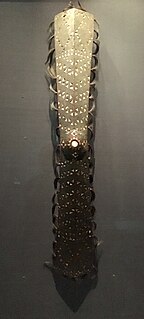
West Sumatra is a province of Indonesia. On the west coast of the island of Sumatra, the province has an area of 42,012.89 km2, and it had a population of 4,846,909 at the 2010 Census and 5,534,472 at the 2020 Census. The province includes the Mentawai Islands off the coast and borders the provinces of North Sumatra to the north, Riau and Jambi to the east, and Bengkulu to the southeast. West Sumatra is sub-divided into twelve regencies and seven cities. It has relatively more cities than other provinces outside of Java, although several of them are relatively low in population compared with cities elsewhere in Indonesia. Padang is the province's capital and largest city.

Mentawai people are the native people of the Mentawai Islands, in Siberut, about 100 miles from West Sumatra province, Indonesia. They live a semi-nomadic hunter-gatherer lifestyle in the coastal and rainforest environments of the islands and are also one of the oldest tribes in Indonesia. The Mentawai population is estimated to be about 64,000. The Mentawai tribe is documented to have migrated from Nias – a northern island – to the Mentawai islands, living in an isolated life for centuries until they were discovered in 1621 by the Dutch. The ancestors of the indigenous Mentawai people are believed to have first migrated to the region somewhere between 2000 to 500 BCE. The Mentawai language belongs to the Austronesian language family. They follow their own animist belief system called Arat Sabulungan, that links the supernatural powers of ancestral spirits to the ecology of the rainforest. When the spirits are not treated well or forgotten, they might bring bad luck like illnesses and haunt those who forgot them. Mentawai also have very strong belief towards objects they think are holy. The people are characterized by their heavy spirituality, body art and their tendency to sharpen their teeth, a practice they feel makes one beautiful. Mentawai tend to live in unison and peace with the nature around them because they believe that all things in nature have some kind of spiritual essence.

The Manggarai are an ethnic group found in western Flores in the East Nusa Tenggara province, Indonesia. Manggarai people are spread across three districts in the province, namely the West Manggarai Regency, Manggarai Regency and East Manggarai Regency.

Rumah adat are traditional houses built in any of the vernacular architecture styles of Indonesia, collectively belonging to the Austronesian architecture. The traditional houses and settlements of the several hundreds ethnic groups of Indonesia are extremely varied and all have their own specific history. It is the Indonesian variants of the whole Austronesian architecture found all over places where Austronesian people inhabited from the Pacific to Madagascar each having their own history, culture and style.

Niabor is a curved sword from Borneo, a characteristic weapon of the Sea-Dayaks.

The Pandat is the war sword of the Dayak people of northwest Borneo and is never used as a tool. On October 18, 2016, this weapon was featured in season 3 episode 9 of the American bladesmithing competition series Forged in Fire.
Parang Nabur is a sword that originates from Banjarmasin, South Kalimantan, Indonesia. Most of these swords were made during the Banjarmasin Sultanate period in the 19th century.

Sewar refers to a dagger of Indonesian origin, typically carried in a belt and used mainly in Sumatra, Indonesia. The blade is also referred to as Sewah by the Gayo people, Seiva by the Minangkabau people, Siva by the Alas people, and Siwaih by the Acehnese people.

Palitai is the traditional knife of the Mentawai people, originating from the Mentawai Islands off West Sumatra, Indonesia.

Kabeala is a traditional weapon originating from East Sumba, Indonesia.

Wedung is a traditional large knife of the Javanese people and the Balinese people originating from Indonesia.

A Piso Halasan is a traditional sword of the Batak people from North Tapanuli Regency, North Sumatra, Indonesia.
Alamang or Sonri is a sacred sword or cutlass of the Bugis and Makassarese people in Sulawesi, Indonesia.

A Salawaku, is a traditional shield originating from the Maluku Islands, Indonesia. It is also known as Ma Dadatoko, Salwake, Saluwaku or Salawako in Galela, Salewaku-mu in Loloda, Hawau-mu in Madole, Emuli in Buru or O Dadatoko in Tobelo.

Peurise Teumaga or Peurise Lembaga is a shield originating from Aceh, Indonesia. This shield is very identical to the Peurise Awe, except that it is made of brass instead of rattan. The shield was also used by Acehnese warriors during the Aceh War against the Dutch colonials in the 19th century.

Peurise Awe or Peurise Awi is a shield originating from Aceh, Indonesia. The shield was used by Acehnese warriors during the Aceh War against the Dutch colonials in the 19th century.

The Klebit Bok or Kelavit Bok is the traditional shield of the Kayan and the Kenyah people originating from Borneo. It is similar to the shields used by other Dayak people such as the Kliau of the Iban.

Salukat or Saloekat is a traditional quiver of the Mentawai people originating from the Mentawai Islands, Indonesia.
Taiganja are precious metal ornaments found in Central Sulawesi, Indonesia, especially in the Sigi Regency. They are used as a kind of jewelry to enhance the status of the wearer, or as protective amulets. The core shape of the taiganja, reminiscent of the female genitalia, is an endemic shape that has been found throughout the Southeast Asian region.

Pisau raut is a whittling knife that is commonly as a tool to prepare the rattan and other fine carving found throughout the entire Malay archipelago. It is well known as an accompanying knife placed in the same sheath with the mandau, a traditional weapon of the Dayak people.




















